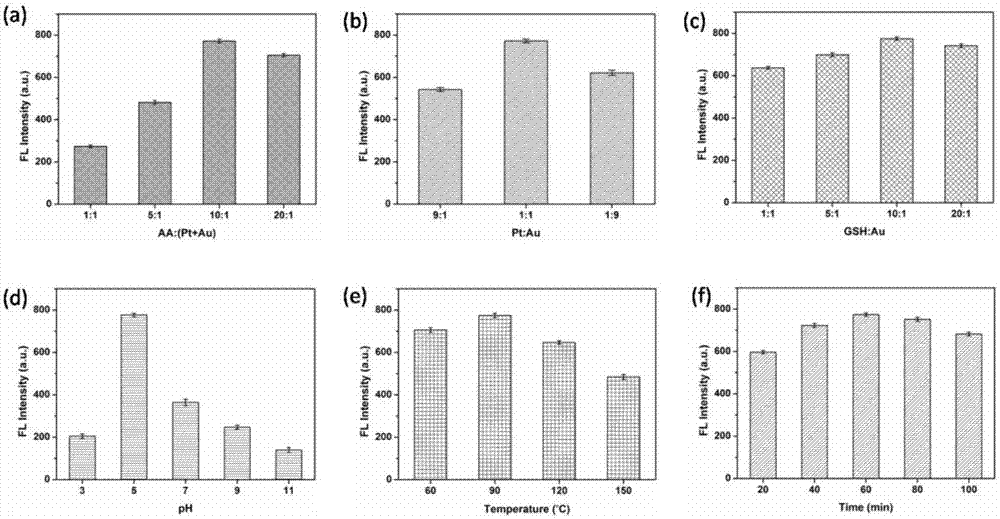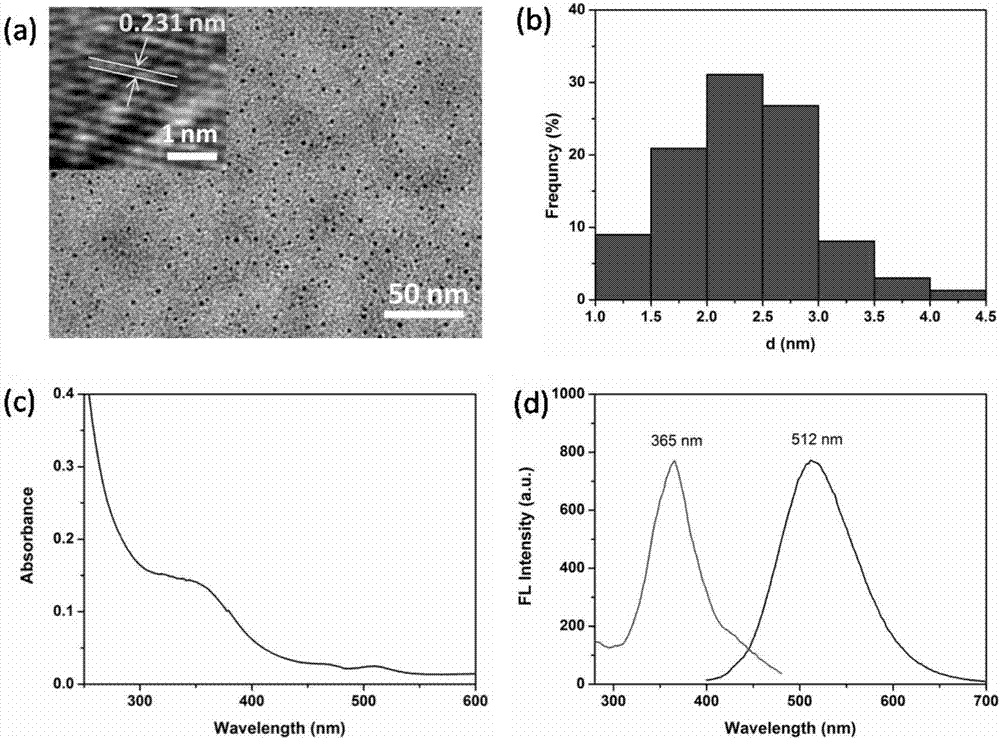Gold/platinum bimetal nanocluster fluorescence probe based on polyethyleneimine protection, and application of fluorescence probe in aureomycin detection
A polyethyleneimine and bimetallic nanotechnology, applied in the field of fluorescent probes, can solve the problems of difficult operation, complicated methods and processes, etc.
- Summary
- Abstract
- Description
- Claims
- Application Information
AI Technical Summary
Problems solved by technology
Method used
Image
Examples
Embodiment 1
[0025] 1.25 μmol H 2 PtCl 6 ·6H 2 O and 1.25 μmol HAuCl 4 ·3H 2 O was dissolved in 10 mL of ultrapure water containing 25 μmol GSH, and after stirring for 20 minutes, 2.5 μmol PEI was added, and after 2 hours, 2.5, 12.5, 25, and 50 μmol AA were added respectively, so that the molar ratio of AA to (Pt+Au) was 1 :1, 5:1, 10:1 and 20:1. Then, the pH value of the mixed system was adjusted to 5 with 1.0 M HCl solution. Afterwards, the mixture was put into a 50mL autoclave, and subjected to hydrothermal reaction at 90°C for 60min to obtain polyethyleneimine-protected gold / platinum bimetallic nanoclusters (Au / PtNCs) with different AA amounts (moles). .
[0026] The results show that: when the molar ratio of AA to (Pt+Au) is 10:1, that is, when the AA in the reaction solution is 25 μmol. The fluorescence intensity of Au / PtNCs is the highest.
Embodiment 2
[0028] 2.25, 1.25, 0.25 μmol H 2 PtCl 6 ·6H 2 O and 0.25, 1.25, 2.25 μmol HAuCl 4 ·3H 2 O (the molar ratio of Pt to Au is 9:1, 1:1 and 1:9, respectively) was dissolved in 10mL ultrapure water containing 25μmol GSH, after stirring for 20min, 2.5μmol PEI was added, and after 2h, 25μmol AA was added . Then, the pH value of the mixed system was adjusted to 5 with 1.0 M HCl solution. Afterwards, the mixture was put into a 50mL autoclave and hydrothermally reacted at 90°C for 60min to obtain polyethylenimine-protected gold / platinum bimetallic nanoclusters (Au / PtNCs) under different molar ratios of Pt to Au.
[0029] The results show that when the molar ratio of Pt to Au is 1:1, the H in the reaction solution 2 PtCl 6 ·6H 2 O and HAuCl 4 ·3H 2 When O is 1.25 μmol and 1.25 μmol respectively. The fluorescence intensity of Au / PtNCs is the highest.
Embodiment 3
[0031] 1.25 μmol H 2 PtCl 6 ·6H 2 O and 1.25 μmol HAuCl 4 ·3H 2 O was dissolved in 10 mL of ultrapure water containing 2.5, 12.5, 25, and 50 μmol GSH respectively (the raw material molar ratios of GSH to Au were 1:1, 5:1, 10:1, and 20:1), and after stirring for 20 min, Then 2.5 μmol PEI was added, and after 2 h, 25 μmol AA was added. Then, the pH value of the mixed system was adjusted to 5 with 1.0 M HCl solution. Afterwards, the mixture was put into a 50mL autoclave, and hydrothermally reacted at 90°C for 60min to obtain polyethylenimine-protected gold / platinum bimetallic nanoclusters (Au / PtNCs) under different molar ratios of GSH to Au.
[0032] The results show that: when the molar ratio of GSH to Au is 10:1, that is, when the GSH in the reaction solution is 25 μmol. The fluorescence intensity of Au / PtNCs is the highest.
PUM
 Login to View More
Login to View More Abstract
Description
Claims
Application Information
 Login to View More
Login to View More - R&D
- Intellectual Property
- Life Sciences
- Materials
- Tech Scout
- Unparalleled Data Quality
- Higher Quality Content
- 60% Fewer Hallucinations
Browse by: Latest US Patents, China's latest patents, Technical Efficacy Thesaurus, Application Domain, Technology Topic, Popular Technical Reports.
© 2025 PatSnap. All rights reserved.Legal|Privacy policy|Modern Slavery Act Transparency Statement|Sitemap|About US| Contact US: help@patsnap.com



